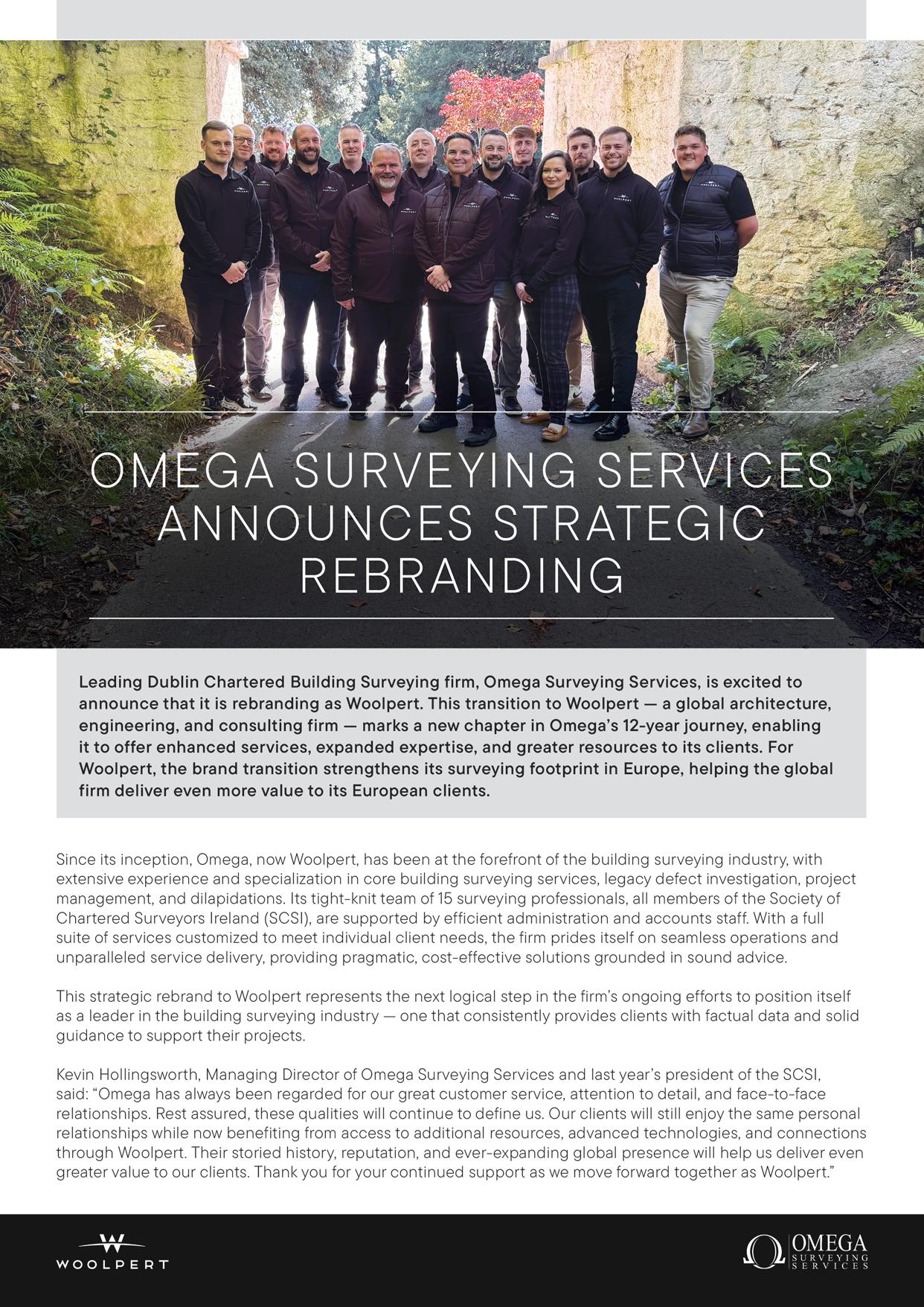JOURNAL

SCSI
SCSI







RECOGNISING EXCELLENCE
WHY YOU SHOULD ENTER THE 2025 SURVEYING EXCELLENCE AWARDS.
Every day, Chartered Surveyors across Ireland deliver expertise, professionalism, and integrity in ways that shape our built environment and improve lives. Whether navigating complex valuations, leading transformative construction projects, enhancing sustainability, or managing land and property with care – your work matters. The 2025 Surveying Excellence Awards, hosted by the SCSI, is your opportunity to pause, reflect, and receive the recognition your contribution truly deserves. The awards are more than a ceremony. They are a celebration of the outstanding achievements across the surveying profession – large or small, individual or team based. They shine a light on the talent, innovation, and commitment that define being a Chartered Surveyor in today’s ever-evolving landscape.
Too often in our busy professional lives, we move from one project to the next without acknowledging just how much we’ve accomplished. But now is the time to change that. These awards are not just for headline-grabbing megaprojects or high-profile firms. They are designed to recognise you – whether you’re early in your career or a seasoned expert, working in urban centres or rural communities, making incremental improvements or delivering bold transformations.
So, why enter?
Celebrate your achievements: Whether you’ve introduced a new process, gone above and beyond for a client, or led a project that created real community impact, this is your chance to share your story.
PRESIDENT’S MESSAGE
Gerard O’Toole SCSI President

Raise your professional profile: Being shortlisted – or winning – signals excellence to peers, clients, and the wider industry. It’s a mark of trust, quality, and professionalism.
Inspire others: Your work could motivate fellow surveyors, especially younger professionals, by showing what’s possible in this diverse and dynamic profession.
Promote the value of surveying: Each entry helps showcase the vital role surveyors play in shaping the world around us – from housing and infrastructure to heritage and sustainability.
We understand that modesty often comes with the territory. Many Chartered Surveyors work diligently behind the scenes and rarely seek the spotlight. But, if there’s ever a time to step forward and be recognised, it’s now. Your story could be exactly what our profession – and the public – needs to hear.
The 2025 Surveying Excellence Awards are open for entries across a range of categories, designed to reflect the breadth of disciplines and talents within our membership. Entry is straightforward, and guidance is available every step of the way.
Let this be the year you take pride in your work and allow others to celebrate it with you. Recognition is not about boasting – it’s about sharing success, inspiring excellence, and lifting the entire profession.
Enter the 2025 Surveying Excellence Awards. You’ve already done the hard work. Now it’s time to be recognised for it.
Visit scsi.ie/awards for full details and entry guidelines.

MAINTAINING STANDARDS
THIS EDITION FEATURES A NUMBER OF ISSUES THAT ARE OF IMPORTANCE TO THE PROFESSION, FROM REGULATION TO CONTINUING PROFESSIONAL DEVELOPMENT.
This edition of the Surveyors Journal covers a wide range of subjects, reflecting the variety of interests, roles, and activities of surveyors practising and researching in Ireland.
In the first of a new series of articles on professional regulation, Gwen Wilson, SCSI Director of Regulation and Registrar, focuses on the importance of appropriate checks that can be taken to ensure that those claiming to adhere to professional standards are doing so legitimately. On page 11, Gwen outlines some steps that can be taken to verify qualifications, an important means of maintaining standards and ensuring public trust.
On page 10, there is a note reminding readers that the Society needs more APC assessors, counsellors and supervisors. This is not surprising given the growth of the profession in recent years. Familiar to all chartered members, the APC is a fundamental part of the process of becoming chartered. It is the ultimate and appropriately rigorous assessment where the high standards required for membership are finally determined. As those who participate know, the involvement of experienced members is a vital ingredient in the assessment process and contributes greatly to its rigour. It is also a rewarding way in which experienced members contribute to maintaining the much-respected standards in the profession. I encourage members to consider becoming involved. Finally, I would like to draw readers’ attention to the feature on page 15 by Dr Frank Prendergast, Emeritus Research Fellow, TU Dublin. Frank tells us about a collaboration between three organisations to capture and rigorously analyse the spectacle of the 17-minute-long phenomenon that recurs after sunrise on December 21 every year at Newgrange Passage Tomb in Co. Meath. He outlines the plan to livestream this phenomenon to a global audience and to capture, map and record the imagery for posterity. I think readers will find this truly fascinating.
Tom Dunne Editor EDITORIAL

PLANNING PERMISSIONS IN IRELAND Q2 2025
7,447
Number of dwelling units granted planning permission (down 12.5% on Q2 2024)
Percentage of dwellings granted permission that were houses (down 6.4% on Q2 2024)
3.2%
63%
Decrease in the number of one-off houses receiving planning permission
Annual decline in the number of dwelling units granted planning permission across the four local authorities of Dublin
1.9%
Annual growth in the total number of Strategic Housing Development dwelling units approved 35.5%
Source: Central Statistics Office –https://www.cso.ie/en/releasesandpublications/ep/p-
It was fantastic to have over 200 young professionals attending our 2025 Nexus Ball at the Radisson Golden Lane in Dublin on October 9.
Nexus is the SCSI’s network of young professionals and newly qualified surveyors. If you would like to build your network, give back to your community, and make a difference, please get in touch to find out how you can get involved in the Nexus Committee by visiting scsi.ie/nexus.
From left: Nexus Committee members Amy Kerr, Cushman and Wakefield; Alison Manning, Bannon; Robbie Hughes, JLL; Gavin Boyle, Townlink; and Nicole Territt, Savills; Shirley Coulter, SCSI CEO; Gerard O’Toole, SCSI President; Ailbhe O’Sullivan, Knight Frank and Nexus Chairperson; Ruth Comerford-Morris, SCSI Deputy Director of Education; and, Committee members Joanna Phelan, Cushman and Wakefield; Cliona Lenehan, CBRE; John Landers, Colliers; Lauren Reilly, CBRE; Jodie Heeney, Murphy Mulhall; and, Jayne Brennan, JLL. Photograph: Dermot Byrne.
NEXUS BALL 2025


SHOWCASE YOUR COMPANY: PARTNER WITH US

Find out about our range of sponsorship and advertising opportunities to expand your brand awareness this year. Choose from a range of event sponsorship and exhibition opportunities, including:
n SCSI Annual Dinner;
n National Conference;
n Nexus young professional sporting events and ball; n professional conferences; n regional conferences;
n SCSI networking and sporting events; and, n CPDs and seminars.
Whether you are looking to expand your brand awareness, engage with senior industry leaders or grow your graduate recruitment, we will work to provide you with tailored opportunities to suit your goals.
Visit our sponsorship page to find out more, or contact our team at events@scsi.ie.
ENGAGING WITH FUTURE SURVEYORS AND STUDENTS
The SCSI is delighted to engage with future surveyors and students on our accredited courses this autumn. If you know someone considering their career options, encourage them to visit the SCSI stands at: n Holy Family Secondary School, Newbridge – November 13; n Maynooth Education Campus – November 18; or, n Villiers School, Limerick – November 18.
APC workshops
Our education team is also looking forward to delivering APC workshops to professionals at a number of member firms this autumn, including Savills, Lisney, Mitchell McDermott, Colliers, Knight Frank, JLL, Suir Engineering, CBRE, and more. Book a free APC workshop for your team at scsi.ie/apcworkshop/.

1-2-1 career chats
We’re here to help people connect with great careers in property, land, and construction. If you or someone you know has questions about surveying careers or courses, you can book a free 1-2-1 career chat with the SCSI education team at scsi.ie/apc-support/.

Student membership
We also look forward to connecting with students on our accredited programmes in the upcoming months. Students can sign up online to become student members of the SCSI for free! Please share the online SCSI Student Member application form, at scsi.ie/student/, with any surveying students you know.

ANNUAL GOLF DAY SCSI/IRISH TIMES ANNUAL TENNIS TOURNAMENT

It was fantastic to have 18 teams take part in our 2025 Annual Golf Day. Congratulations to the winning team from MMP – Mulcahy McDonagh & Partners! Thank you to all who took part in this year’s event.

The 36th SCSI/Irish Times Annual Tennis Tournament took place on Thursday, August 21, at Donnybrook Tennis Club, with 12 teams competing. For the second year in a row, Independent Valuations took the title with a 10-8 win over the Irish Times team.
Congratulations to the winning team from Independent Valuations –Patrick Sheehan, Myles Fleeton, Rimiko Ogata, and Sarah Colville!

HAVE YOUR SAY: 2025 REMUNERATION & WORKPLACE SURVEY

The 2025 SCSI Remuneration & Workplace Survey is now live. On Tuesday, September 23, members received a link from our research partner, inclusio. This confidential survey, which takes 10 to 15 minutes to complete, will deliver valuable benchmarks on pay, benefits, and workplace
experiences, helping to shape a clearer picture of salaries and culture across the surveying profession.
The survey also addresses a range of workplace issues. Members are reminded that LionHeart, the charity dedicated to supporting the surveying community, offers
a wide range of services for SCSI members. More details are available at scsi.ie/lionheart or by calling 01-223 9446. We encourage every member to take part –every response matters. If you experience any issues or have questions, please contact communications@scsi.ie.
OBITUARY – NOEL H. McDONAGH FSCSI FRICS ACIARB

Noel McDonagh passed away peacefully on May 24, 2025, after a short illness borne with great spirit and strength.
Noel had a long and distinguished career as a Chartered Quantity Surveyor (QS), which began in the 1950s. He qualified as a member of the Royal Institution of Chartered Surveyors (RICS) in 1957, and commenced his career with Mulcahy & Associates, becoming a partner in 1961 and senior partner in 1972. Noel began a lifelong interest in the QS profession through involvement in the RICS Republic of Ireland Branch. His energies, along with others’, assisted in the RICS recognition of full-time education courses for QSs in Bolton Street College of Technology in the 1960s and 1970s. In the area of research, Noel served on the board of An Foras Forbartha Teoranta from 1970 until 1987. He was Chairman of the National Building Elements Committee in the 1980s, which produced the National Standard Building Elements and Design Cost Control Procedures, which were widely adopted by the construction industry in Ireland. In 1971 and 1972 Noel was elected Chairman of the RICS Republic of Ireland Branch. He played an important part in the establishment of The Society of Chartered Surveyors, which has equal recognition with RICS educational qualifications for the benefit of all. In the 1970s he became an Associate of the Chartered Institute of Arbitrators. Noel also developed the firm he joined in the 1950s to become one of the leading Chartered
Quantity Surveying practices in Ireland – Mulcahy McDonagh & Partners. In 1990/91 he was elected President of the QS Division of the RICS (worldwide), becoming the first Irish person to hold the position. A Europe-wide organisation emerged in the late 1970s related to the sharing of knowledge and methodologies among construction economists – the European Council of Construction Economists (CEEC). Noel was a delegate to the CEEC for many years and from 1985 to 1988 was its President. From 1983 to 1986 he served on the board of the CIB, formally the International Council for Research and Innovation in Building and Construction – the first Irishman to have the distinction of serving.
The University of Salford conferred Noel with an honorary doctorate in 1997. He was a visiting professor to Liverpool John Moores University, the University of Salford and Northumbria University, as well as extern examiner to many Irish colleges. In 2006 he was awarded an honorary doctorate by Technological University Dublin for his lifelong interest in education and research for Chartered Surveyors.
Following retirement from Mulcahy McDonagh & Partners in 1991, Noel devoted his energies to Self Help Africa, a charity that he helped to set up in 1984, and served as its Chairman until his retirement in 2006. He was selected as one of the Rehab Group’s ‘People of the Year’ in 1995 for third world aid. He also managed to find time to take up golf.
Noel is survived by his beloved wife, Moira, children Mark, Brian and Hilary, eight grandchildren, extended family, neighbours, friends and colleagues. Ar dheis Dé go raibh a anam dílis.
HELP THE NEXT GENERATION OF CHARTERED SURVEYORS

Take a step up in your career and support the next generation of Chartered Surveyors by becoming an APC Counsellor, Supervisor, or Assessor.
We are particularly in need of more assessors, counsellors, and supervisors from the residential, property finances and investment, property and facilities management, and planning and development disciplines.
As part of this process, you will receive training, and have the opportunity to connect with other professionals helping to support candidates on their journey to chartership.
Visit scsi.ie/getinvolved or contact Ruth Comerford Morris at ruth@scsi.ie.
KRA RELAUNCHES SOUTHERN REGION OFFICE IN DUNGARVAN
KRA is pleased to announce the relaunch of its southern region office in Dungarvan, Co. Waterford. The company states that this renewed base strengthens its presence in the south east and ensures enhanced support for clients across the wider southern region.
From the Dungarvan office, KRA states that it will deliver its full suite of services, combining local expertise with national capability. The reestablishment of a dedicated regional hub reflects KRA’s commitment
JOB SEARCH
CONSTRUCTION
PM and QS positions (graduate to Associate level) Hardy Partnership
Job description: Dynamic opportunities on pharma and data centre projects, to work with international clients, and to learn M&E skills, etc.
Contact: Alan Hardy at alanhardy@hardy.ie or 086-812 7678. Deadline for applications: April 30, 2026. For further information on the firm, see www.hardy.ie.
to supporting growth and providing accessible, on-the-ground expertise to communities, businesses, and projects across Waterford, Cork, and the broader southern region.
According to the company, this investment underlines KRA’s long-term strategy of building strong regional connections while continuing to deliver the highest standards of service to clients throughout Ireland.


PROPERTY
Senior surveyor – property management JLL

Job description: JLL Ireland, part of the global real estate services firm with a rich 240-year history in the market, is seeking a senior surveyor to join our property management team based in Dublin.
Contact: Ernesta Rajeckaite, Talent Acquisition PAM, JLL, at ernesta.rajeckaite@jll.com or +44 1603 774259. Deadline for applications: October 31, 2025. For further information on the firm, see www.jll.ie.
BAD BEHAVIOUR
THE FIRST OF A NEW SERIES OF ARTICLES ON PROFESSIONAL REGULATION FOCUSES ON THE IMPORTANCE OF APPROPRIATE CHECKS TO ENSURE THAT THOSE CLAIMING PROFESSIONAL TITLES ARE DOING SO LEGITIMATELY.
For aspiring professionals, the path towards professional title and acknowledgment is best navigated through honesty, perseverance, and a genuine commitment to continued learning. The value of a professional title stems not only from the credential itself, but from the journey taken to achieve it. Upholding this principle ensures that professional titles remain meaningful, respected, and truly reflective of individual merit and societal trust. The use of counterfeit diplomas, certificates, or other forms of misrepresentation can affect the perceived value of authentic qualifications and may impact public trust. Currently in the media spotlight is the case of a ‘doctor’ who attempted to register with the Medical Council as a specialist cardiologist using documents that were later determined to be falsified. The submitted documentation referenced credentials belonging to another doctor in gynaecology and obstetrics, and included signatures that were not genuine.1
The SCSI regulation team is investigating a similar case, where someone may have used another Registered Building Surveyor’s registration number with the same name. Right now, SCSI regulation is reviewing and enhancing its verification processes through its independently led Standing Committee on
Regulation and Standards to reduce risk and continue to ensure that qualifications from both within and outside the State comply with the required standards.
Verifying qualifications
SCSI members who are employers are encouraged to verify qualifications to maintain standards and public trust. Here are some steps you can take:
1. Direct contact with educational institutions: Employers can contact the educational institution directly to verify the candidate’s qualifications. This can include confirming the degree, dates of attendance, and the authenticity of the diploma or certificate. Quality and Qualifications Ireland (QQI – https://www.qqi.ie/) is an excellent resource to establish level of qualification (e.g., Level 6, 7, 8, or 9).
2. Request official transcripts: Employers can ask candidates to provide official transcripts from their educational institutions. These transcripts can be used to verify the courses taken and the grades achieved.
3. Check the Register: Employers can use online registers maintained by professional bodies to verify if the candidate is listed as a qualified professional. This is particularly useful for professions that require registration or licensing. For example, at the SCSI you can Check the Register (https://scsi.ie/check/) or Find an Expert (https://scsi.ie/find/).
4. Look for red flags: Be cautious of any discrepancies in the candidate’s educational history, such as institutions that are not accredited, degrees obtained in an unusually short period, or inconsistencies in the information provided.
Gwen Wilson LLB SCSI Director of Regulation and Registrar

Reference
1. Malone E. Doctor found guilty of attempting to use fake diplomas to register with Medical Council. The Irish Times, June 10, 2025. Available from: https://www.irishtimes.com/health/2025/06/10/doctor-found-guilty-of-disgraceful-behaviourover-attempt-to-use-fake-diplomas-to-register-with-medical-council/
SPOTLIGHT ON CONSTRUCTION
THE RECENT SCSI CONSTRUCTION + QS CONFERENCE FEATURED FASCINATING DISCUSSIONS ON VITAL ISSUES FOR THE SECTOR.
The SCSI Construction + QS Conference, an annual hybrid event, was held recently in the SCSI HQ and attended by over 100 surveyors. The event had an all-star line-up of speakers with four main themes. The Conference was opened by SCSI President Gerard O’Toole, who stated that the programme promised to be insightful and thought-provoking, bringing together a rich blend of voices from Government, industry, and international thought leadership. He said that the conference was taking place at a pivotal time for our industry. The housing market remains under immense pressure, with supply-side challenges undermining affordability. While price inflation may have slowed, the systemic issues in planning, infrastructure delivery, and skills shortages remain unresolved. Commercial property, meanwhile, has faced headwinds from interest rate volatility – yet some sectors are seeing renewed investor appetite.
The future of investment
During the first session, entitled ‘The future of investment’, Caroline Timmons, Assistant Secretary at the Department of Housing, outlined Ireland’s strategy to boost housing supply and affordability through major public investment, reform, and innovation. Since launching Housing for All, 140,000 new homes have been delivered. A revised goal targets 303,000 homes by 2030, backed by €6.8 billion in capital for 2025. Caroline stressed three enablers: upgraded land use and infrastructure planning; streamlined planning approval via the Planning and Development Act 2024; and, stronger financing tools, including rent reforms and private investment. She also highlighted the need for
Mary C. Flynn FSCSI
FRICS MAPM MSc BIMM Assistant Chief Quantity Surveyor
Surveyors Division

modern methods of construction (MMC), supported by cost studies, a national roadmap, pilot projects, and skills.
Kevin Timoney from Davy discussed the Irish economy in detail, including the state of exports, corporation taxes, non-corporation tax, labour income, and income tax. He also looked at population growth, immigration, and housing, bringing a uniquely data-driven view of market fundamentals. This was followed by a lively panel discussion chaired by Colin Richardson, Head of Research for CBRE, which discussed the future of construction investment and policy shifts, especially in affordable housing and economic stability.
Cost drivers and productivity
The second session, on ‘Cost drivers and productivity’ was introduced by Lisa Rocca, Chief Executive of Forca Property Advisory. Lisa joined fellow industry leaders Filippo Cavassini of the OECD, and Tomás Kelly of AECOM to explore rising cost challenges, the importance of data-led decision-making, and opportunities to modernise procurement and delivery models.
Filippo presented on housing affordability, investment, and construction costs from a global perspective. Insufficient housing investment is a key factor behind worsening affordability across OECD countries. From 2015 to 2024, house price-to-income ratios have increased significantly, highlighting disconnects between supply and demand. Global investment trends show that investment levels remain below pre-2008 and pre-Covid trends, contributing to slower potential gross domestic product (GDP) per capita growth. Productivity growth in construction
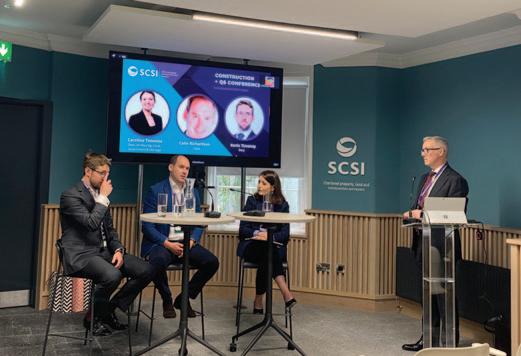
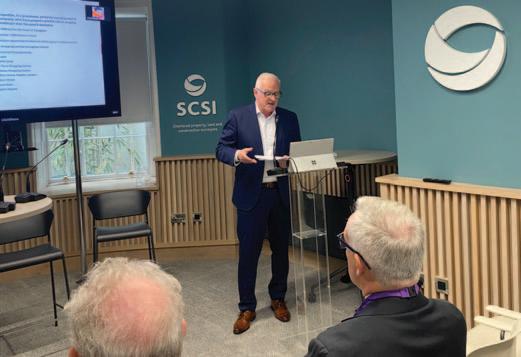
lags behind other sectors (e.g., manufacturing), signalling room for innovation and reform. The ecological and digital transitions are set to reshape the construction industry with a greater need for digital skills across the workforce. There is also a rise in demand for off-site construction, modular techniques, and smart systems.
Tomás Kelly covered issues concerning how the sector is composed of a fragmented industry, which creates issues for innovation. He finished on a high note – that the Building Information Modelling (BIM) Mandate and digitalisation are all positive initiatives.
Construction trends
The third session explored ‘Construction trends’, and chair Kevin Brady opened the session on the topic of regulations and procurement. This was followed by Philip Kaheru’s presentation on the evolution and impact of the International Cost Management Standard (ICMS) in creating transparent, efficient, and sustainable construction practices. ICMS 3 (2021) integrated carbon data, aligning cost control with environmental goals. Philip outlined how the ICMS enhances investment visibility, supports environmental, social and governance (ESG) goals, and improves procurement processes. It also aligns with MMC by integrating with BIM, digital twins, and AI-driven forecasting.
Dr Daniel McCrum, Director of MMC Research, University College Dublin, spoke about standardisation of MMC. The future of MMC standards points to greater codification, digital integration, and opensource adoption. Initiatives like STANDARDIZE aim to unify fragmented systems into national or international frameworks, improving safety, energy efficiency, and durability. Key trends include performance-tested typologies, regulatory reforms, digital interoperability (e.g., BIM), and increased investor confidence through testable, repeatable systems. Compared to traditional, in-situ methods, MMC offers tested, scalable, and digitally compatible solutions with better off-site precision. While conventional construction is more flexible for bespoke projects, MMC excels in delivering speed, scale, and sustainability.
The final presenter in this session was Mark Wearen from Kroll. Mark highlighted the vital role Chartered Quantity Surveyors (QSs) play in managing and preventing construction disputes. Beyond cost control, QSs serve as consultants, administrators, and expert witnesses
throughout a project’s life cycle. Mark attributed disputes mainly to unclear contracts, poor communication, and design phase oversights. To mitigate these risks, QSs should ensure accurate estimates, update contingencies, and promote clarity through standardised procurement. Post contract, they must substantiate claims with clear assessments and documentation. He pointed to supportive frameworks like NEC4 contracts, Project Boards, and the SCSI’s alternative dispute resolution (ADR) guidance. He also noted efforts to develop future adjudicators through the SCSI Pupillage Scheme. Emphasising a sector-wide cultural shift, he endorsed the RICS-led Conflict Avoidance Coalition’s pledge to make conflict prevention a professional norm, positioning QSs as key champions of project integrity.
Rubble to rails
The final session was titled ‘Rubble to rails: the Cork South Docks Sustainability Project’. This session was chaired by Emer Byrne from TU Dublin, with presentations by Martin Murphy of MMOS Engineers, Joe Keane of O’Callaghan Properties, and Dr Colin Rynne from University College Cork.
The R&H Hall project in Cork’s South Docklands, led by O’Callaghan Properties, involved the sustainable demolition of two historic grain silos from 1934 and 1952. The project emphasised heritage preservation, regulatory compliance, and circular economy principles. Archaeological analysis traced the site’s industrial past, while laser scanning and salvage work ensured architectural documentation. Structural assessments confirmed the silos were beyond repair, prompting their removal. A detailed demolition plan balanced safety, public access, and environmental concerns. Demolished concrete was repurposed into 6F2 recycled aggregate under the EU Waste Framework Directive and Endof-Waste Regulation. Achieving a 99.997% recycling rate, the project set a national precedent. It exemplifies an innovative, sustainable approach to redevelopment, integrating technical precision with environmental and cultural stewardship. Major challenges include rising costs, legislative complexity, and skills shortages. To address this, the sector is embracing MMC, now used in 31% of new builds, alongside digital tools like BIM to enhance efficiency and standardisation.
THRIVING IN RURAL PRACTICE
THE RURAL SURVEYING PATHWAY IS A FANTASTIC OPPORTUNITY FOR SURVEYORS TO CONTRIBUTE TO MAINTAINING A SUSTAINABLE RURAL ENVIRONMENT.
With an ever-increasing focus on the environment and natural world, the countryside is changing at a rapid rate – making the role of the rural practice surveyor more important and more diverse. The RICS/SCSI Assessment of Professional Competence (APC) rural surveying pathway is ideal for anyone who has a particular interest in contributing to the maintenance and enhancement of a healthy, sustainable rural environment, and the functioning of a vibrant rural economy. The rural pathway places emphasis on competency in agriculture (which is required to a minimum of level 2 in this pathway). However, as with other pathways, a broad base of experience in general rural practice is also required. The rural pathway is quite individual and does not have the same level of crossover as other pathways. There is a crossover with the valuation pathway, however, and candidates undertaking the rural pathway may gain their experience in a valuation context. Valuation can be taken to level 3 on this pathway, providing a route towards Registered Valuer status.
Specialist expertise
The role of the rural surveyor is changing. One of the most marked developments is the increasing level of specialisation that is occurring. Given the rate of change in this space, professional advice on how emerging regulations and practices affect a client’s business plans has never been more valuable. Rural surveyors enable the rural economy and environment to thrive and flourish in a variety of ways by virtue of their experience and expertise across a very broad and diverse range of activities. The work of a rural surveyor draws on a wide range of professional and technical skills and knowledge in key areas, including agriculture, management of the natural environment and landscape, property management, conservation, forestry, valuation, residential and commercial property, and retail. Specifically, rural surveyors may find themselves working across a number of different but complementary areas, for example rural estate management, agriculture, planning, valuation, auctioneering, and asset management, to mention but a few. Being a rural surveyor means understanding how the countryside works, and the interrelationships that exist in terms of the people who live and work there. Rural surveyors are increasingly involved not only in professional and technical aspects, but also in business, resources management, consultancy, and as leaders in the rural community.
Building relationships
James Lonergan SCSI Director of Education & CPD

Rural surveyors will also naturally interact with other surveying professionals such as geomatics surveyors and mineral surveyors when considering potential issues relating to boundaries, the extraction of, for example, gravel or sand from a site, or the potential development of land. The breadth of strategic opportunities that rural surveyors may need to advise clients on means that they need insight into legislation and into a range of disciplines. They also need access to a network of fellow professionals, which SCSI membership can provide, as it’s essential for all members to be aware of the limits of their competency and when it’s appropriate to seek advice from a fellow surveyor. Fostering and maintaining good relationships with clients and fellow professionals is therefore key.
The rural surveying pathway provides a great opportunity not only for new graduates but also for established members. Those who are already Chartered can apply to become a Chartered Rural Surveyor through the Chartered Alternate Designation process. Please contact me or my colleagues in the education team for more information.
MAPPING THE WINTER SOLSTICE LIGHT AT NEWGRANGE
INNOVATIONS IN GEOSPATIAL AND IMAGING TECHNIQUES CAPTURE THE ICONIC SOLAR ILLUMINATION IN HIGH RESOLUTION.

The solar illumination of Newgrange passage tomb, a UNESCO World Heritage Property in Co. Meath, is a 17-minute-long phenomenon that recurs shortly after local sunrise on the winter solstice. The key date and timing of the phenomenon centre around December 21, when the rising sun has cleared the local horizon in the south east. Despite secular changes in the obliquity of the ecliptic (the angular tilt in the Earth’s axis of rotation) and the structural inclination of several passage orthostats (upright stones) closest to the burial chamber, direct sunlight still penetrates the tomb, and has done so ever
FEATURE
Frank Prendergast
PhD AIAU FRICS FSCSI Emeritus Research Fellow Technological University Dublin

since its construction, c. 3200 BC. A collaboration between three organisations set out to capture and rigorously analyse the spectacle, using innovative digital and geospatial methods. In 2020, the event was also livestreamed to a global audience, with repeat transmissions in 2021, 2023, and 2024 in response to public demand. New research summarised here has yielded the first-ever high-resolution composite images of the sunbeam’s path inside the burial chamber, creating a comprehensive digital heritage record now archived by the National Monuments Service (NMS).
First things first – prehistoric ‘real estate’ and timeline
Passage tombs are a type of megalithic monument usually delimited by large, contiguously set kerbstones enclosing a burial chamber with a corbelled roof, which is
accessed by a narrow passage. The burial chamber is typically cruciform in shape, a predominantly Irish custom. Cremation was the principal burial rite during the Neolithic period (4000-2450 BC). Recent archaeological evidence indicates that Newgrange evolved as a built structure around 3305-3020 cal. BC. The external architecture and landscape setting of the monument are shown in Figure 1. The facade is a modern reinstatement that was completed in the 1970s using quartz and granitic cobbles found at the toe of the thencollapsed covering cairn.
Today, the term ‘real estate’ is taken to mean land and its attached tangible structures. Neolithic real estate consisted of stone monuments found near, or remote from, dwelling houses made of timber, always rectangular in plan. Later, during the Bronze Age (2450-800 BC), domestic houses were circular in plan and wedge tombs replaced passage tombs.
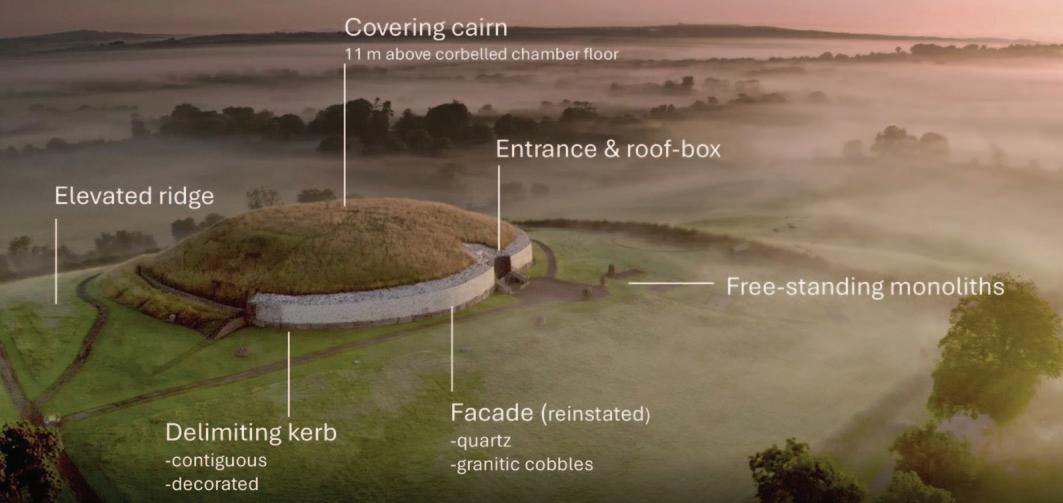

Commissioning of works
Experts from the Office of Public Works (OPW), the NMS and Technological University Dublin devised a plan in late 2020 to livestream the solar illumination phenomenon to a global audience, and to capture, map, and analyse the recorded imagery for posterity. Four remotely controlled motorised dome network-type video cameras (VCAM 1-4) and a Nikon D850 digital camera equipped with a wide-angle lens, also remotely controlled, were deployed as follows:
n VCAM 1 – on the floor of the burial chamber, facing the entrance; n VCAM 2 – overhead the burial chamber floor;
n VCAM 3 – in the roof-box aperture, facing the horizon;
n VCAM 4 – inside the entrance passage, facing the burial chamber; and,
n Camera – focussed and zoomed from above on the burial chamber floor.
Figure 2 illustrates the locations and orientations of the cameras.
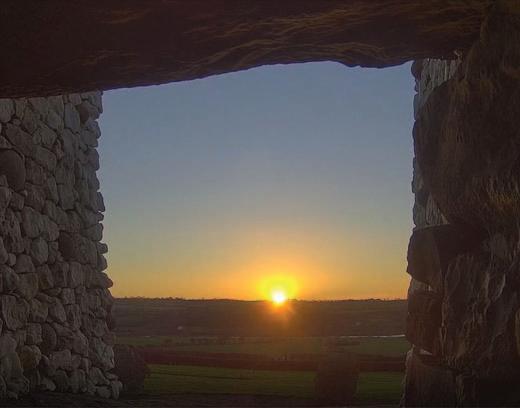
VCAM 3 was orientated to face the rising sun, giving unprecedented views of the spectacle to a global audience (Figure 3).
The elaborate architectural design of Newgrange and the ridge slope combine to restrict direct sunlight from entering the burial chamber. Solar illumination is only possible on winter solstice mornings, when the sun is in alignment with the roof-box – a developed slot opening inserted above the entrance door. Such a construct is not found in any other passage tomb, either in Ireland or northwest Europe ( Figure 4 ).
Broadcast innovations for livestreaming
The technical team installed a microwave data link and the associated network integration to distribute the event to an online audience. Equipment was operated by an outside broadcast (OB) unit manager, programme director, vision engineer, camera operators, and a floor manager. Footage was edited live on site, transmitted to a host platform, and distributed to various digital and social media platforms, giving global access.


FIGURE 5: Composite image of sunbeam ingress on December 24, 2020, at 09:00:06 UTC. True North is 1°.2 west of Grid North (meridian convergence) and the grid interval is 1m. The image is dated, time stamped, and astronomically referenced. Note the wider beam of ambient light that is ever present in the chamber during daylight hours, year-round.
For the livestream segment, expert commentary by Dr Clare Tuffy and this author augmented the web broadcasts. Both presenters drew on their respective heritage and archaeoastronomical knowledge, receiving unanimous praise from a vast online viewing audience for the commentary’s scientific clarity, simplicity, warmth, and outreach.
Geospatial innovations
Images of the sunbeam phenomenon in the chamber were recorded by
FIGURE 4: The rising sun in 3200 BC near the centre of the roof-box, and in the present day. The northward shift in sun azimuth is caused by the cyclical change in obliquity of the ecliptic over 5,000 years. The sky is mapped with grid co-ordinates in the horizon system (azimuth, altitude) and astronomical equatorial system (right ascension and declination).
the NMS Senior Photographer and later georeferenced to the Irish Transverse Mercator (ITM) (formerly the Irish National Grid). Extant ground control in the chamber was made available for this process, having been previously created by The Discovery Programme during laser-scanning of the monument (Figure 2). Transformation of the images to the ITM reference system was processed in ArcGIS software using an affine first-order polynomial transformation (root mean square error c. 2cm). Recorded images beautifully captured the sunbeam’s ingress and egress in high resolution on many mornings, as well as the six illuminated control points. However, the structural stones were enveloped in near-total darkness in every image. The solution was to record an added image with the burial chamber fully illuminated. Digitally cutting out the gravel floor and layering it above images of the sunbeam in ArcGIS provided the first-ever composite views of the archaeology of the tomb and the sunbeam (Figure 5).
These innovations by a transdisciplinary team have yielded a unique suite of high-resolution composite visualisations of the archaeology of the tomb and the dynamic sunbeam when it illuminates Ireland’s most iconic prehistoric monument on winter solstice mornings
Further information
Readers can access the full research report, a stunning compilation of the solar illumination phenomenon compressed into 20 seconds, and recordings of the 2020 livestreams at the following links:
Prendergast, F. Winter Solstice Phenomenon at Newgrange: Research Report 2024: World Heritage Unit, National Monuments Service, Department of Housing, Local Government and Heritage. 2024. Available from: https://arrow.tudublin.ie/arastart/15/ and https://www.worldheritageireland.ie/wpcontent/uploads/2024/12/1314_World-Heritage-Unit_Winter-Solstice -Research-Report_Final.pdf
National Monuments Service. Winter Solstice Illumination of Newgrange Chamber. 2021. Available from: https://www.youtube.com/watch?v=Gl9_mi6Nj0c. (Two-minute timelapse compilation of high-resolution digital photography.)
Office of Public Works. Livestreams. Winter Solstice at Newgrange 2020. Available from: https://www.gov.ie/en/office-of-publicworks/news/winter-solstice-at-newgrange-2020/
MARKET CONTRAST: STAGNATION AND RECOVERY
THE SCSI’S MID-YEAR REPORTS SIGNAL DIVERGING TRENDS IN THE RESIDENTIAL AND COMMERCIAL PROPERTY MARKETS.
Residential market: supply shortfall drives affordability concerns
The SCSI recently released its ‘ Property MidYear Market Monitor 2025’ report, revealing persistent supply constraints and affordability challenges across Ireland’s housing market. Despite economic stability and moderated inflation, the national Residential Property Price Index rose by 8% year on year, driven by a shortfall in housing completions; at just 30,330 units in 2024, completions were well below the Government’s annual target of 50,000. First-time buyers (FTBs), even dual-income public sector couples, face significant affordability gaps. In commuter counties like Wicklow and Kildare, three-bedroom semidetached homes exceed FTB purchasing capacity by €65,200 and €22,000, respectively. Cork remains the only county where all surveyed house types are deemed affordable (Table 1).
The rental sector continues to represent a challenge for attracting new investment, with 29% of sales instructions coming from landlords exiting the market, though this trend is down from the 40% reported last year. Complex legislation, low returns, and recovery from negative equity are cited as key drivers. Following recent rental reforms, 71% of agents expect further landlord departures.
Energy efficiency is emerging as a market differentiator, with over half of agents reporting that homes with a Building Energy Rating (BER) of B2 or higher command premiums of 5-10%. Green mortgages and energy cost savings are the primary motivators for buyers.
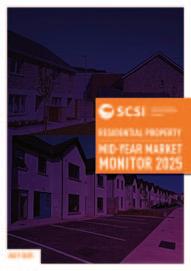
The full report can be found on the SCSI website at www.scsi.ie


Edward McAuley SCSI Director of Practice & Policy

Table 1: Affordability gap of a new three-bed semi-detached home in five counties.
Location Meath Kildare Wicklow Cork Galway

Commercial property market shows signs of recovery amid global headwinds

Ireland’s commercial property market is entering a transitional phase, with the latest SCSI ‘Commercial Property Market Monitor’ indicating cautious optimism. While investor sentiment remains subdued, occupier demand is recovering, particularly in the industrial sector, which posted a +15% net balance in Q2 of 2025, up from +13% in Q4 of 2024.
This trend aligns with global patterns reported in the Royal Institution of Chartered Surveyors (RICS) Global Commercial Property Monitor (GCPM), where industrial occupier demand led all sectors, with a +10% net balance globally. In the Americas, industrial demand was especially strong, with the US posting a +23% net balance for overall tenant demand – the ninth consecutive quarter of positive growth.
In Ireland, prime office and retail assets are showing modest growth, with capital and rental value expectations at +2.5% and +2.6%, respectively, for prime offices, and +1.0% and +1.8%, respectively, for prime retail.
These figures are broadly in line with European expectations, where prime office and industrial sectors saw upgraded capital value projections in Q2 of 2025, according to the RICS.
Investor demand in Ireland remains flat, with a 0% net balance in Q2 of 2025, down from +5% in Q4 of 2024. This mirrors the global picture, where the RICS investment enquiries metric edged down to +7% globally, and foreign investment enquiries remained negative at -10%.
Notably, the US saw a sharp drop in foreign investment interest, falling from -6% to -29%.
Credit conditions in Ireland have improved, with 35% of surveyors reporting better access to financing, compared to just 16% noting deterioration. This is consistent with the US, where credit conditions rose to a +30% net balance, while Canada stagnated at +2%.
Valuation sentiment in Ireland is stabilising. In Q2 of 2025, 57% of respondents viewed the market as fairly valued, up from 11% in Q2 of 2023. Globally, the RICS found that 50% of contributors now see their markets as fairly valued, with only one-third viewing them as expensive. Looking ahead, both reports highlight the growing importance of sustainability and wellness. In Ireland, 86% of surveyors expect tenants to demand enhanced health and well-being features, and 68% believe they’ll pay a premium for them. Globally, the RICS notes that data centres and student housing are expected to outperform traditional sectors, with projected capital value growth of 3-4% over the next year. Overall, the Irish commercial property market is in an early recovery phase, with 51% of surveyors identifying the sector as either in early or mid-upturn, a sentiment echoed across Europe, where 49% of RICS respondents believe their markets are in an upswing (Figure 1).
PLANNING FOR THE FUTURE – BUILDING INVESTMENT FUNDS PART I
THE FIRST ARTICLE IN A TWO-PART SERIES LOOKS AT THE LIFE CYCLE OF A BUILDING, AND WHY BUILDING INVESTMENT
FUNDS ARE A VITAL PART OF LONG-TERM ASSET MANAGEMENT.
Assets, in the context of the built environment, are the major components of buildings. They range from roofs, windows, heating systems, lifts and life safety systems to electrical fittings, carpets, and landscaping, and require a management and funding approach that spans the full life cycle of each component – from cradle to grave. Stewardship of these physical assets is critical to achieving the optimal operational performance of each building and to supporting healthy living environments for all residents. Central to long-term asset management planning are the building investment fund (BIF) and BIF report, which provide the foundations and future framework for decision-making in respect of asset refurbishments and renewals, and the capital funds necessary to deliver these.
What is a building investment fund?
A BIF, also commonly referred to as a sinking fund, is normally established in the early stages of a building’s life cycle to fund the gradual replacement of wasting or depreciating assets in a development and its buildings. BIFs are essential to ensure that multiunit developments (MUDs) have sufficient financial resources over their life cycle to fund the capital costs associated with the refurbishment and renewal of assets. In the case of MUDs subject to
FEATURE
Aoife O’Sullivan
Property and Asset
Management Lead
The Land Development Agency

the MUD Act 2011, it is a requirement to have a BIF in place, with the Act providing a guide for an annual contribution per unit of €200. However, it is accepted that this notional amount set out in legislation is insufficient to meet the long-term funding needs of MUDs. Therefore, in carefully planning for the financial requirements of a building’s life cycle, it is critical that a full understanding of its assets, their serviceable life, and the cost of replacement is established at an early stage.
The early preparation of a BIF report and plan is fundamental to this.
Building life cycle stages
Understanding a building’s life cycle is key to developing the BIF report or plan. While every building is unique – with varying refurbishment and renewal requirements that are influenced by a variety of factors, such as construction quality, design details, resident use–age interaction, and the standard of operational maintenance – most individual buildings follow a similar pattern as they move through their life cycles.
Figure 1 illustrates five general life cycle stages. These stages, when understood, allow building owners and operators to anticipate future maintenance, capital and resourcing requirements, supporting future decisionmaking. Maintenance costs should be consistent throughout the life of a building, whereas expenditure relating to asset renewals and refurbishments will vary significantly over the building’s life cycle.
Stage 1: Pre-natal (0-1 year)
At this stage, the building is new and in the process of being handed over from developer to owner(s). Assets are covered by warranties, with minimal maintenance requirements outside of regular servicing. There should not be any plans to replace assets unless some premature failure has occurred.
Stage 2: Childhood (1-16 years)
While most of the focus at this stage is on routine cleaning and maintenance, it is common for smaller refurbishment and renewal projects to be undertaken, as some assets – e.g., pumps, carpets, motors, and exterior/interior painting – will have shorter life cycles and require more frequent replacements than others. Short-life assets
<1 year 1-16 years 17-29 years 30-49 years 50+ years
will continue to require cyclical replacement during all the subsequent life cycle stages of a building, and need to be factored into the longer-term plan for building refurbishments and renewals.
Stage 3: Adolescence (17-29 years)
This is the period when many of a building’s assets will have reached the end of their serviceable life and will require either upgrade or complete replacement, resulting in an uplift in refurbishment/renewal projects and capital costs. Many building assets are designed with a 20- to 25-year useful life and viewed as midlife assets. Also pertinent at this stage is obsolescence, which may affect the availability of parts for repairs, and which in turn necessitates the complete replacement of equipment. This can include fire alarm systems, roofs, lifts, heating systems, and glazing systems, and it is not uncommon to see multiple projects at this stage of the life cycle.
Stage 4: Adulthood (30-49 years)
It is at this point that the largest and most expensive projects will occur. Refurbishment and renewal projects that can be expected at this stage in the life cycle involve windows, cladding, road surfaces, and paved areas. Some of the short- and mid-life assets will also be due their second or even third round of renewals at this point, making it a complex stage in the building’s life cycle to manage, with multiple assets at various ages requiring work and capital funding.
Stage 5: Old age (50+ years)
At this point, all the major assets will have
n Construction/acquisition
n Routine maintenance
n Capital renewal
been through one renewal cycle, reducing capital expenditure needs and resetting the life cycle back to Stage 2. Many buildings will operate beyond the fifth stage of their life cycle once they are adequately maintained, and assets are refurbished and renewed in good time. Essential to this longevity is proper, early planning for the physical assets and the capital necessary to fund future renewal projects. This critical planning is supported by the early preparation of a BIF report.
Relationship between routine operations and building life cycle
Day-to-day operations and the approach to longer-term asset renewals and refurbishments are intrinsically linked. Proper maintenance of a building’s assets in line with the original installers’ guidelines will potentially not only improve the operating efficiency of each asset, but also extend its serviceable life, influencing when assets may require replacement and future capital inputs. Conversely, when assets are not replaced or upgraded at the end of their serviceable life, it is likely to result in increased maintenance and repair costs to address failing assets, resulting in higher annual operating costs. It follows that the relationship between how assets are managed and maintained day to day and how they are planned for long term has significant implications for a building’s operational efficiency, costs, and future requirements in terms of major upgrades and capital costs.
Part 2 of this series will look at managing the life cycle stages of a building and the role of the BIF report.
BALANCING FLEXIBILITY AND SAFEGUARDS
THE SCSI’S SUBMISSION TO GOVERNMENT ON EXEMPTED DEVELOPMENT REFORMS ADVOCATES A BALANCED APPROACH.
The SCSI recently made a detailed submission to the Minister for Housing, Local Government and Heritage in response to a public consultation on proposed changes to exempted development provisions under the Planning and Development Regulations. These reforms, which would allow certain categories of development to proceed without the need for planning permission, represent one of the most significant proposed updates to Irish planning regulations in almost a generation. The submission strongly supports the principle of reducing unnecessary administrative burdens on planning authorities and unlocking capacity for larger, more complex projects. However, it also highlights the need for safeguards, professional oversight, and public guidance to ensure that the reforms deliver housing, agricultural, and infrastructure benefits, without undermining consumer protection, building safety, or the integrity of Ireland’s built environment.
FEATURE
Edward McAuley SCSI Director of Practice & Policy

Why now?
The Government’s proposals come at a time when planning authorities are under mounting pressure. Ireland’s housing demand continues
to outpace supply, with local authority planning departments stretched to capacity. The consultation seeks to introduce new categories of exempted development,
including detached habitable garden units of up to 40 square metres, attic conversions, roof alterations, and subdivisions of existing dwellings, while expanding exemptions for agricultural, educational, healthcare, and infrastructure works.
On paper, these reforms could significantly reduce the number of routine applications requiring assessment. But as our submission notes, the details matter. Exemptions that appear minor in isolation can, in practice, create unintended consequences for safety, conveyancing, and long-term planning policy.
The case for a pragmatic amnesty
A distinctive feature of the submission is its call for a targeted amnesty to address historic planning non-compliance. Thousands of Irish homeowners have carried out extensions, alterations, or minor works over the last 25 years without formal planning permission, often in good faith but without clarity on the rules. These issues surface most acutely during conveyancing, when solicitors are forced to trawl planning files back to the 1960s to verify compliance.
“
THE SUBMISSION STRONGLY SUPPORTS THE PRINCIPLE OF REDUCING UNNECESSARY ADMINISTRATIVE
BURDENS
ON PLANNING
AUTHORITIES
AND UNLOCKING CAPACITY FOR LARGER, MORE COMPLEX PROJECTS. HOWEVER, IT ALSO HIGHLIGHTS THE NEED FOR SAFEGUARDS, PROFESSIONAL OVERSIGHT, AND PUBLIC GUIDANCE.
The results are delay, cost and, in some cases, failed property transactions. The SCSI’s ‘Residential Market Monitor’ report has consistently identified these as barriers to efficiency in the housing market.
By formally regularising low-risk, longstanding works carried out in the last two decades, the State could significantly accelerate property sales and purchases, while reducing administrative backlogs in the legal system. The SCSI submission is clear, however, that such a measure must be carefully designed to avoid incentivising future non-compliance, and should exclude cases where permission was explicitly refused.
Domestic development: the fine balance
Domestic exemptions are at the heart of the proposed reforms, and it is here that the submission goes into greatest detail.
Attic conversions and roof alterations
These can provide valuable additional space, but also carry risks relating to fire safety, structural stability, and energy efficiency. The submission advocates that such works should only be carried out by builders registered with the Construction Industry Register Ireland (CIRI), with clear homeowner guidance on compliance and risks, such as solar battery storage in attics.
Detached habitable units
The proposal to exempt garden units of up to 40 square metres could provide flexibility for families and help to unlock accommodation. The submission highlights the need for regulations to prevent misuse, recommending commencement notices to local authorities to maintain oversight and ensure that these are not used as unregulated rentals. Only one unit per site should be permitted, with rules on privacy, setbacks, and wastewater capacity.
Subdivisions of dwellings
Perhaps the most sensitive proposal, this carries the risks of overcrowding, fire safety breaches, and pressure on local infrastructure. The SCSI again recommends commencement notices, a limit of one subdivision per property, and safeguards against unregulated conversions by unqualified builders.
The submission also stresses the need for comprehensive public guidance documents, making it crystal clear that planning exemptions do not remove obligations to comply with building regulations, or fire safety and building control requirements.
Agricultural sector: supporting modern farming
The proposals include increasing exemption thresholds for agricultural buildings from 200 to 300 square metres, reflecting the realities of modern farming. Data from the ‘SCSI/Teagasc Agricultural Land Review 2025’ show growing average farm sizes, generational renewal, and increased land leasing, all of which drive demand for larger, more efficient farm structures.
The SCSI supports this increase but emphasises the need for limits on aggregate floor area and careful siting to avoid visual or environmental impacts.
More contentious is the proposal to exempt slurry storage facilities up to 1,500 cubic metres. While larger storage capacity is needed to comply with the Nitrates Directive, the SCSI warns that this represents a very significant departure from the current rules. The SCSI suggests either scaling back the threshold or introducing strict design and siting standards to protect waterways, neighbours, and rural amenity.
Institutions and infrastructure: easing bottlenecks
For schools, hospitals, and other public institutions, the proposed exemptions would allow larger permanent extensions, longer use of temporary classrooms and wards, and the installation of active travel infrastructure and renewable energy systems. The SCSI supports these measures, recognising their potential to cut red tape and deliver essential services more quickly. Infrastructure exemptions are also set to expand, particularly for electric
vehicle (EV) charging facilities. Here, the SCSI calls for national technical standards to ensure safety, fire risk management, and emergency access. Without such safeguards, the benefits of rapid roll-out could be undermined by avoidable risks.
Protecting heritage
The submission reaffirms the importance of Section 57 of the Planning and Development Act 2000, which requires clarity and permission for works to Protected Structures. Expanding exemptions should never be allowed to weaken protections for Ireland’s architectural heritage, particularly as demand grows for retrofitting, external insulation, and renewable technologies in historic buildings.
Conclusion: reform with responsibility
The Government’s consultation on exempted development represents a pivotal opportunity to modernise planning rules for a changing Ireland. By reducing administrative bottlenecks, supporting housing supply, and enabling sustainable rural and infrastructure development, the reforms could unlock significant economic and social benefits.
However, as the SCSI stresses, the success of these reforms depends on balance. Without safeguards, expanded exemptions risk fuelling noncompliance, undermining consumer protection, and creating new bottlenecks in future conveyancing.
The dual approach advocated by the SCSI – prospective clarity through well-structured exemptions and retrospective relief through a pragmatic amnesty – offers a practical pathway forward. By combining flexibility with accountability, the State can achieve its housing and infrastructure goals while preserving safety, heritage, and long-term quality in the built environment.
THURSDAY
IS MART DAY
LISA KEENAN IS A THIRD-GENERATION AUCTIONEER AND MART MANAGER BASED IN CO. CAVAN, WHERE HER FAMILY HAVE BEEN IN THE PROPERTY AND MART BUSINESSES FOR OVER 50 YEARS.
For Lisa Keenan, running a mart is something she was born and bred to do. Lisa’s grandfather and father ran marts and sold property around the Fermanagh–Leitrim border: “When we were small, we used to be loaded up and brought up to Fermanagh to the marts. I’d be running around the mart, gathering cattle and picking cattle and loading cattle. Marts were always big in my world”.
Lisa studied auctioneering, valuation and estate agency at Bolton Street (now TUD). She spent a year at Oxford Brookes University before qualifying with a degree in real estate management in 2003. Then it was straight to work in the family business. When her father passed away in 2005, she took the reins: “The business then comprised Keenan Auctioneers, Kingscourt Mart, a mart in Garrison, Co. Fermanagh, and some property in Fermanagh as well. Around 2012, we decided to pull the plug on Fermanagh and just concentrate all our efforts around Kingscourt”.
Lisa’s brother Donal has since taken over Keenan Auctioneers, freeing Lisa up to focus her attention on running Kingscourt Mart, although she still advises and assists with trading entitlements, land auctions, and valuations. No two days are alike, she says: “From one day to the next, it’s very varied. The only constant down through the years is that Thursday is mart day. That never changes. You

can’t take your eye off the ball on a Thursday –it’s all hands on deck”.
As a female mart manager in an industry long dominated by men, Lisa knows the value of a balanced workplace: “As far as I know, I’m the only female livestock auctioneer operating in the country. There should be more, definitely. You need a mix. I have two female drovers working in the mart, and it brings such a fantastic balance to the place. It’s a better mart as a result”.
Over the years, she has seen attitudes change: “I’ve been selling cattle since I was 16, and I feel years ago, there was a bit of resistance and resentment when you got up to sell cattle. But to be honest, now you step up and you’re just there to do a job. There are so many women in agriculture now. In my family, growing up, there was no such thing as a man’s job or a woman’s job. You just got stuck in and you did whatever you could. I was always surrounded by very strong females –both physically and mentally”.
A lifeline for farmers
This summer, Lisa launched a new platform for selling cattle. The system is designed for farmers with a herd that has been restricted –typically due to a tuberculosis (TB) outbreak. It enables them to sell the restricted cattle to Controlled Finishing Units (CFUs), or feedlots. Having noticed the lack of an outlet for these herds, Lisa saw an opportunity: “It’s something that hadn’t been done in the country. Basically, if a farmer’s herd goes down with TB, they can’t sell TB-restricted cattle in the sales. If the cattle aren’t fit for the factory, they’ve very few markets available to them. The cattle can’t
leave the farm to come to the sales, so the sales go to them. We replicate the mart process as much as possible. We go out and take a video – it’s similar to an auctioneer promoting a house. We send the details to all our CFUs, have an online auction every Tuesday morning, and they can bid on these cattle over MartEye (an auction software app). We’ve just tapped into a market that was dead”. Lisa and her team have already had overwhelmingly positive feedback: “It’s put thousands into the pockets of farmers because they’re getting a fair value for their cattle now. We’re just so happy to have opened up a lifeline for farmers that have their herds locked up”.

Outside of work, Lisa loves sports, the outdoors, and making time for farming when she can. Her passion for Gaelic football has endured almost as long as her love of the mart: “This year, Meath were doing very well. We were getting to relive our youth as Meath fans back in the day when we were winning All-Irelands. It’s a great community to celebrate. So, we were up in Croke Park a few times this year”.
THE SILENT CRISIS
PLANNED, PREVENTIVE MAINTENANCE AT SCALE IS URGENTLY NEEDED TO SAVE OUR TRADITIONAL BUILDINGS.
There is no shortage of public and expert commentary on the urgent need to tackle Ireland’s growing crisis of vacant and derelict buildings. But that noise and consensus ignores one glaring, uncomfortable truth. Ireland’s traditional built environment – our pre-1900s building stock – is slowly, quietly, and relentlessly deteriorating before our eyes. And we are doing almost nothing to stop it.
The length and breadth of Ireland are lined with streetscapes shaped by our traditional buildings. They are more than bricks and mortar; they are our shared identity, our character, our history, and our heritage. And today, many of them are clinging to life by a thread.
Despite the significance of these buildings, the people who own and live in these buildings –many of whom take great pride in their upkeep – are being left to shoulder impossible burdens. Enhancement schemes may offer superficial relief, but we continue to ignore the true costs of responsible care.
The most effective, economical, and responsible approach to safeguarding our traditionally built streetscapes is not lastminute rescue. It is proactive, planned preventive maintenance. Keeping these buildings dry, stable, and structurally sound is not just good practice – it is a civic duty, and a form of public service. If we do not act
WORD
Sarah Sherlock BSc (Geomatics) PgDip
FSCSI

now,today’s occupied historic buildings will become tomorrow’s derelict ones. And we will have no one to blame but ourselves.
The hidden costs will be less if addressed at scale
Maintaining our traditional building stock is expensive, technical, and at times heavily regulated, and the cost is being borne by individuals who are often the least equipped to manage it. I recently spoke with someone who needed to replace two ridge tiles and four slates on a three-storey townhouse in a provincial town. The cheapest quote?
Nearly €5,000:
n a certified lift hire or scaffolding was required;
n a permit had to be secured from the local authority to cordon off the footpath; n skilled tradespeople were needed; n matching slate had to be sourced; and, n labour for safe access and installation had to be hired.
This example is the rule, not the exception, and it is driving well-intentioned owners to despair. If we are serious about maintaining the streetscapes in our towns and villages, we need to scale this work up, reduce individual costs, and remove systemic barriers.
Time for action
What we need now is a national strategy for the planned preventive maintenance of Ireland’s traditional building stock, with action embedded at the heart of every local authority. It needs to incorporate:
n specialised grants and tax incentives that reflect the true cost of maintenance;
n skilled workforce development: a national initiative to train, certify, and connect tradespeople versed in traditional construction methods;
n access to technical expertise: advisory services for property owners on appropriate materials and interventions; and, n local authority-led maintenance schemes.
Let’s get moving!
We must recognise and properly support the people who are quietly holding our traditional streetscapes together at personal cost, with little thanks, and even less help. With the right policy, the right investment, and the right focus, Ireland’s towns and villages can once again thrive, not as museum pieces, but as living parts of our national story.
It’s time to act with integrity, support the stewards of our streetscapes, and protect the hearts and souls of our beautiful historic towns and villages, before it’s too late.
